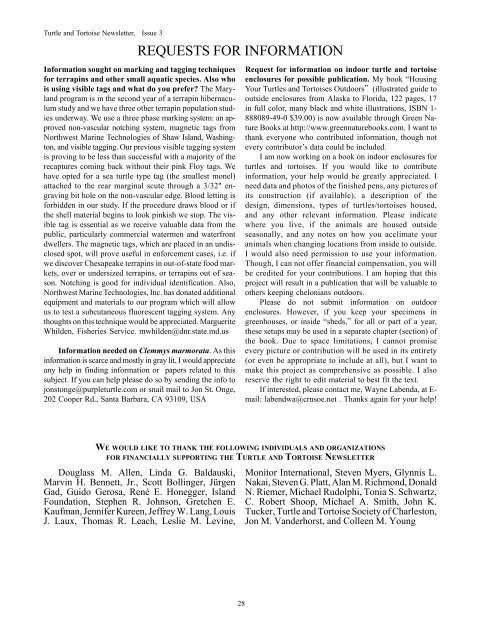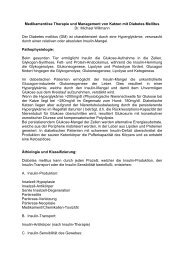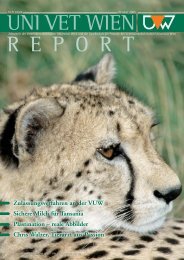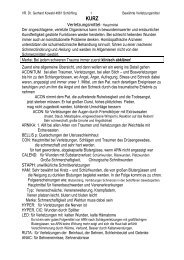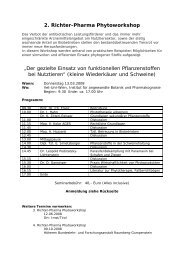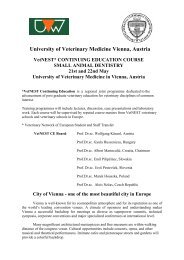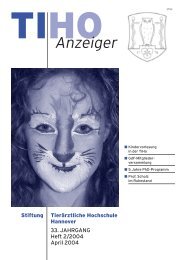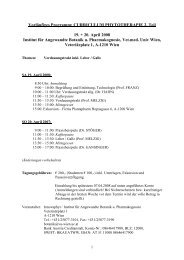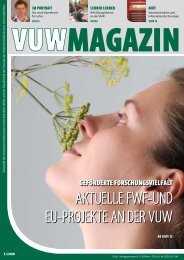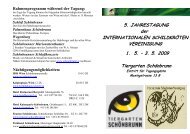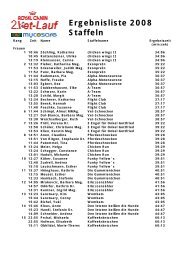Turtle and Tortoise Newsletter - VET-MAGAZIN.com
Turtle and Tortoise Newsletter - VET-MAGAZIN.com
Turtle and Tortoise Newsletter - VET-MAGAZIN.com
You also want an ePaper? Increase the reach of your titles
YUMPU automatically turns print PDFs into web optimized ePapers that Google loves.
<strong>Turtle</strong> <strong>and</strong> <strong>Tortoise</strong> <strong>Newsletter</strong>, Issue 3REQUESTS FOR INFORMATIONInformation sought on marking <strong>and</strong> tagging techniquesfor terrapins <strong>and</strong> other small aquatic species. Also whois using visible tags <strong>and</strong> what do you prefer? The Maryl<strong>and</strong>program is in the second year of a terrapin hibernaculumstudy <strong>and</strong> we have three other terrapin population studiesunderway. We use a three phase marking system: an approvednon-vascular notching system, magnetic tags fromNorthwest Marine Technologies of Shaw Isl<strong>and</strong>, Washington,<strong>and</strong> visible tagging. Our previous visible tagging systemis proving to be less than successful with a majority of therecaptures <strong>com</strong>ing back without their pink Floy tags. Wehave opted for a sea turtle type tag (the smallest monel)attached to the rear marginal scute through a 3/32" engravingbit hole on the non-vascular edge. Blood letting isforbidden in our study. If the procedure draws blood or ifthe shell material begins to look pinkish we stop. The visibletag is essential as we receive valuable data from thepublic, particularly <strong>com</strong>mercial watermen <strong>and</strong> waterfrontdwellers. The magnetic tags, which are placed in an undisclosedspot, will prove useful in enforcement cases, i.e. ifwe discover Chesapeake terrapins in out-of-state food markets,over or undersized terrapins, or terrapins out of season.Notching is good for individual identification. Also,Northwest Marine Technologies, Inc. has donated additionalequipment <strong>and</strong> materials to our program which will allowus to test a subcutaneous fluorescent tagging system. Anythoughts on this technique would be appreciated. MargueriteWhilden, Fisheries Service. mwhilden@dnr.state.md.usInformation needed on Clemmys marmorata. As thisinformation is scarce <strong>and</strong> mostly in gray lit, I would appreciateany help in finding information or papers related to thissubject. If you can help please do so by sending the info tojonstonge@purpleturtle.<strong>com</strong> or snail mail to Jon St. Onge,202 Cooper Rd., Santa Barbara, CA 93109, USARequest for information on indoor turtle <strong>and</strong> tortoiseenclosures for possible publication. My book “HousingYour <strong>Turtle</strong>s <strong>and</strong> <strong>Tortoise</strong>s Outdoors” (illustrated guide tooutside enclosures from Alaska to Florida, 122 pages, 17in full color, many black <strong>and</strong> white illustrations, ISBN 1-888089-49-0 $39.00) is now available through Green NatureBooks at http://www.greennaturebooks.<strong>com</strong>. I want tothank everyone who contributed information, though notevery contributor’s data could be included.I am now working on a book on indoor enclosures forturtles <strong>and</strong> tortoises. If you would like to contributeinformation, your help would be greatly appreciated. Ineed data <strong>and</strong> photos of the finished pens, any pictures ofits construction (if available), a description of thedesign, dimensions, types of turtles/tortoises housed,<strong>and</strong> any other relevant information. Please indicatewhere you live, if the animals are housed outsideseasonally, <strong>and</strong> any notes on how you acclimate youranimals when changing locations from inside to outside.I would also need permission to use your information.Though, I can not offer financial <strong>com</strong>pensation, you willbe credited for your contributions. I am hoping that thisproject will result in a publication that will be valuable toothers keeping chelonians outdoors.Please do not submit information on outdoorenclosures. However, if you keep your specimens ingreenhouses, or inside “sheds,” for all or part of a year,these setups may be used in a separate chapter (section) ofthe book. Due to space limitations, I cannot promiseevery picture or contribution will be used in its entirety(or even be appropriate to include at all), but I want tomake this project as <strong>com</strong>prehensive as possible. I alsoreserve the right to edit material to best fit the text.If interested, please contact me, Wayne Labenda, at E-mail: labendwa@crusoe.net . Thanks again for your help!WE WOULD LIKE TO THANK THE FOLLOWING INDIVIDUALS AND ORGANIZATIONSFOR FINANCIALLY SUPPORTING THE TURTLE AND TORTOISE NEWSLETTERDouglass M. Allen, Linda G. Baldauski,Marvin H. Bennett, Jr., Scott Bollinger, JürgenGad, Guido Gerosa, René E. Honegger, Isl<strong>and</strong>Foundation, Stephen R. Johnson, Gretchen E.Kaufman, Jennifer Kureen, Jeffrey W. Lang, LouisJ. Laux, Thomas R. Leach, Leslie M. Levine,Monitor International, Steven Myers, Glynnis L.Nakai, Steven G. Platt, Alan M. Richmond, DonaldN. Riemer, Michael Rudolphi, Tonia S. Schwartz,C. Robert Shoop, Michael A. Smith, John K.Tucker, <strong>Turtle</strong> <strong>and</strong> <strong>Tortoise</strong> Society of Charleston,Jon M. V<strong>and</strong>erhorst, <strong>and</strong> Colleen M. Young28


